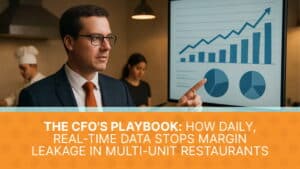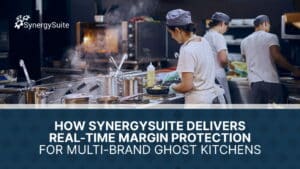I’ve worked with hundreds of restaurant owners, from first-time operators opening their first fast casual restaurant to seasoned pros running multi-unit fine dining establishments. One thing is clear: your restaurant concept isn’t just about food. It drives everything: your price point, your labor costs, your service style, and how you compete in a crowded restaurant industry.
Whether you’re launching a sleek fine dining restaurant, a casual dining spot, or a no-frills food truck, understanding the different types of restaurants (and what it really takes to run them) is step one in building something that lasts.
Let’s break down the most common restaurant types, including what works, what doesn’t, and what it takes to make each profitable.
Fine Dining: High Risk, High Reward
Running a fine dining restaurant (think Ruth’s Chris Steak House or chef-owned “destination restaurants”) isn’t for the faint of heart. It’s a full-on commitment to precision, high quality ingredients, seasonal or fixed-price menus, and trained staff who can talk wine pairings and present a dish like it’s art.
The upside? Fine dining builds prestige, attracts loyal guests, and commands top price points. The downside? Labor costs are high, and consistency is everything. If you’re going this route, budget for staff training, flawless table service, and an upscale ambiance, because one sloppy plate or rushed server can sink a guest’s entire dining experience.
Casual Dining Restaurants: The Crowd Pleasers
If fine dining is about exclusivity, casual dining is about accessibility. Think Applebee’s, Olive Garden, or your neighborhood grill. These casual dining restaurants win by offering familiar comfort foods, a relaxed atmosphere, and menu variety that works for everyone—families, dates, and young professionals.
Here’s why operators love it:
- Moderate price points pull in a broad audience.
- Promotions (happy hours, themed nights) build repeat traffic.
- Delivery and take-out add extra revenue streams.
The challenge? Margins can get squeezed if you don’t control portion sizes and labor. But with the right service style, a mix of table service and takeout-friendly packaging, casual restaurants stay scalable.
Fast Casual Restaurants: Quality Meets Speed
Fast casual restaurants are the sweet spot between fast food and casual dining. Brands like Chipotle built an empire by serving higher-quality ingredients with faster counter service and no need for servers.
Why it works:
- Lower labor costs than full table service.
- Customers love the mix of fresh food and quick turnover.
- Digital ordering and self-serve kiosks keep operations lean.
For owners, fast casual thrives in high-traffic areas and appeals to health-conscious, on-the-go diners.
Fast Food Restaurants: Volume Over Frills
Fast food restaurants (your Taco Bell, McDonald’s, or other fast food establishments) are all about efficiency. Quick service, tight menus, and high-volume throughput mean profits scale with speed.
Margins can be great if you lock in consistent suppliers and optimize for labor efficiency. But standing out in this space means strong branding, speed, and tech that keeps orders moving.
Food Trucks & Pop-Up Restaurants: Low Risk, High Buzz
Want to test a concept without dropping six figures on a buildout? Food trucks and pop-up restaurants are your answer.
Why operators love them:
- Lower startup costs than full-service restaurants.
- Easy to move to high-traffic zones or events.
- Perfect for building hype around a new menu (or testing fusion cuisine).
Pop-ups and seasonal concepts create urgency, such as limited-time experiences, drive lines, and social media buzz.
Family Style Restaurants: Built for Groups
Family-style restaurants and family-style dining win with big portions and a communal dining experience. Think Italian platters, Southern comfort spreads, or buffet restaurants with hearty shared dishes.
It’s approachable, casual dining that thrives on groups, celebrations, and multi-generational families. The challenge? Portion control and food waste can crush margins if not managed tightly.
Coffee Shops & Specialty Drink Shops: Small Menu, Big Margins
Coffee shops and specialty drink shops (bubble tea, matcha bars) are quietly some of the smartest plays in the food service business. High-quality ingredients like craft coffee or cold-pressed juice pull in premium price points, and drinks have better margins than meals.
But success isn’t just about caffeine, it’s about atmosphere. Coffee shops thrive as social hubs and workspaces; specialty drink shops rely on Instagram-worthy drinks to drive foot traffic.
Ghost Restaurants: Delivery-Only Hustle
Ghost restaurants (or virtual kitchens) are exploding in the restaurant industry. No dining room, no table service, just delivery via apps. Operators love the low overhead and ability to run multiple concepts from one kitchen.
The catch? You live and die by your digital reputation. Fast delivery, strong branding, and great packaging are non-negotiable.
Why Picking the Right Restaurant Type Matters
Choosing the wrong restaurant type can burn cash fast. Your dining concept impacts everything—service style, staffing, price point, and guest expectations.
Here’s the operator truth:
- Fine dining builds prestige but is labor-heavy.
- Casual dining and fast casual balance volume and experience.
- Fast food and quick service restaurants win on speed and consistency.
- Food trucks and pop-up restaurants are great for testing ideas.
- Specialty spots (coffee shops, ghost restaurants) crush it when they own a niche.
Know your audience, control your costs, and pick a model you can execute consistently.
The Future of the Restaurant Industry
The restaurant industry is moving fast with plant-based menus, automation, and hybrid models (think counter ordering with table service delivery). Whether you’re running a fine dining establishment, a high-volume fast food restaurant, or a contemporary casual restaurant, the winners are the ones who stay adaptable and know their numbers.
The concept you choose today defines your operations tomorrow. Pick smart, stay nimble, and keep an eye on margins.
Streamline Any Restaurant Type with SynergySuite
No matter your concept, fine dining, fast casual, or a single food truck, tight operations mean better profits. SynergySuite gives restaurant owners real-time control over labor, inventory, and compliance so you can focus on guests, not spreadsheets.
Book a demo to see how we help operators run leaner, smarter, and more profitable shifts.





